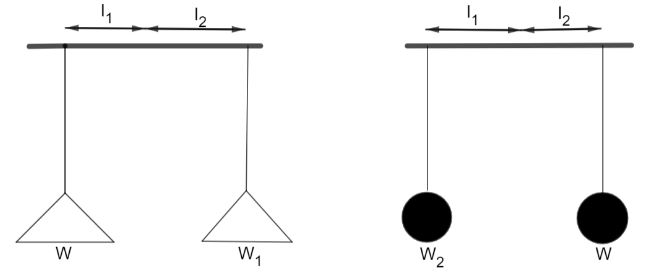
The beam and pans of a balance have negligible mass. An object weighs
A.
B.
C.
D.
Answer
389.1k+ views
Hint: In order to answer this question, we need to understand that a beam balance is working on basis of the principle of moments according to which in the equilibrium, the anti-clockwise moment because of the weight of an object on left pan of the beam is similar to the clockwise moment because of to the standard weights on the right pan of the beam.
Complete step by step answer:
Here,

So,
Now when weight W is kept in pan 2, it reads
Now, dividing equation (1) and (2) we get,
Cross multiplying, we get
Hence, the correct option is (A).
Note: It should be remembered that when a system is in stability or balance, then it is said to be in equilibrium as all the forces experiencing on the system cancel each other out. Common balance is defined as the balance which is having each arm as suspended. The unknown mass is kept in one arm and the known mass in another until they both become equivalent. Therefore, this balance is working on the principle of moment of weights. When the weights are being balanced, equilibrium is attained.
Complete step by step answer:
Here,

So,
Now when weight W is kept in pan 2, it reads
Now, dividing equation (1) and (2) we get,
Cross multiplying, we get
Hence, the correct option is (A).
Note: It should be remembered that when a system is in stability or balance, then it is said to be in equilibrium as all the forces experiencing on the system cancel each other out. Common balance is defined as the balance which is having each arm as suspended. The unknown mass is kept in one arm and the known mass in another until they both become equivalent. Therefore, this balance is working on the principle of moment of weights. When the weights are being balanced, equilibrium is attained.
Recently Updated Pages
Master Class 9 General Knowledge: Engaging Questions & Answers for Success

Master Class 9 English: Engaging Questions & Answers for Success

Master Class 9 Science: Engaging Questions & Answers for Success

Master Class 9 Social Science: Engaging Questions & Answers for Success

Master Class 9 Maths: Engaging Questions & Answers for Success

Class 9 Question and Answer - Your Ultimate Solutions Guide

Trending doubts
State and prove Bernoullis theorem class 11 physics CBSE

Who built the Grand Trunk Road AChandragupta Maurya class 11 social science CBSE

1 ton equals to A 100 kg B 1000 kg C 10 kg D 10000 class 11 physics CBSE

State the laws of reflection of light

One Metric ton is equal to kg A 10000 B 1000 C 100 class 11 physics CBSE

Difference Between Prokaryotic Cells and Eukaryotic Cells




